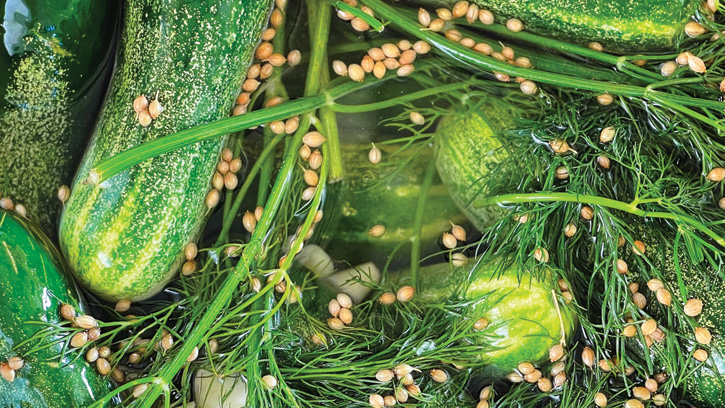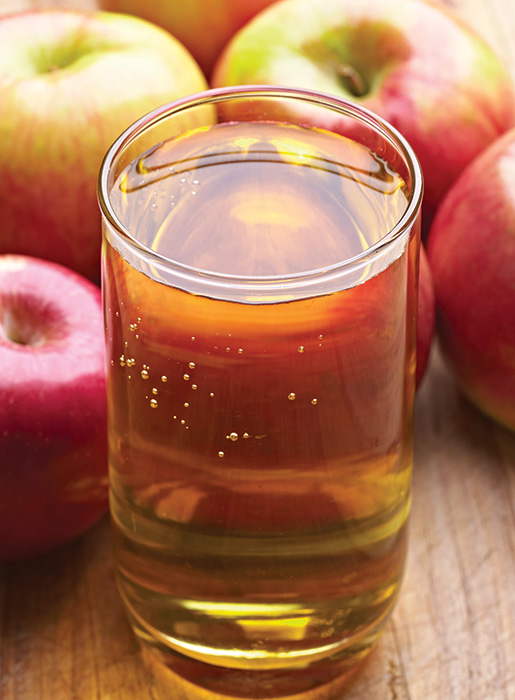Pathogens Can Sour Fermented Food Safety
Safety & Quality | APPLIED SCIENCE
We take for granted that fermented or acidified foods containing organic acids and low pH values are inherently safe and shelf stable. Fermentation has a long history of improving the safety, quality, and sensory characteristics of foods, and we have process controls for food safety based on pH, fermentation time and temperature, organic acid, and salt concentrations.
Scientists at the U.S. Department of Agriculture Agricultural Research Service (USDA-ARS), however, have defined certain conditions that can allow pathogens to survive fermentation and/or acidification. In fact, foodborne illness outbreaks and recalls have been reported from foods that are lightly fermented, such as “half sour” cucumber pickles and kimchi, a spicy fermented cabbage. Acidic drinks like fruit and vegetable juices and ciders have also been implicated in outbreaks.
Let’s take a look at the perils of unexpected pathogens turning up in fermented or acidified foods like these and how they can be reduced through additional hurdles.
Requirements for Safety: pH and Salt
Most microorganisms grow best in a pH range near neutral—6.0 to 8.0. Growth of anaerobic toxin-producing bacteria such as Clostridium and Bacillus cannot occur in pH solutions lower than 4.6, but some bacteria, such as acidophiles, can grow at lower pH values. Another class of microbes, aciduric bacteria, can tolerate low pH solutions but can only survive rather than grow. Enteric pathogens such as E. coli O157:H7 and some Salmonella species can grow at pH values as low as 4.5.
Beneficial lactic acid bacteria (LAB), such as Lactobacillus plantarum and Leuconostoc species used to ferment vegetables, can grow in media as low as pH 3.5. Naturally occurring LAB microflora on produce are relied on to outcompete and eliminate pathogenic bacteria during fermentation.
Fermentation brines also include salts such as sodium chloride and calcium chloride to inhibit undesirable, pathogenic bacteria. LABs are halotolerant bacteria and can grow in brines containing 6% or more sodium chloride. Commercial cucumber fermentations, for example, are usually carried out in salt solutions in ambient temperatures (20°C or above). The combination of salt and temperature favors the fermentation of LABs over the growth of pathogens; all of these microbes are naturally present on the vegetables and in the outdoor environment where fermentation tanks are located. By producing lactic, acetic, and other organic acids during fermentation, LABs inhibit or destroy bad bacteria in fermented products.
Organic Acid Effects
Organic acids are carbon- and hydrogen-containing compounds that have acidic properties. Commonly used for food preservation and microbial inhibition, they include lactic, acetic, malic, and citric acids. They are produced by certain microbes in milk and vegetable fermentations and occur naturally in fruit juices.
Organic acids promote bacterial cell death because these acids can passively enter the bacteria cell through the cell wall when in protonated or nondissociated form. Once inside the cell, the organic acid dissociates and releases a proton that lowers the pH of the cell cytoplasm. The bacteria react by pumping out protons to bring the pH back up to normal. This requires energy, so the cell eventually runs out of steam and can no longer remove the excess acid. The cell wall integrity fails, and the cell bursts.
Certain conditions, however, can increase pathogenic bacteria’s tolerance to acid. Several labs have demonstrated that prior nonlethal exposure to low concentrations of organic acids, or growth in media with fermentable sugars such as glucose, can create acid-adapted pathogens. USDA-ARS researchers found that E. coli O157:H7 grown on media with a fermentable sugar (1% glucose) produced acid-adapted bacteria (Buchanan and Edelson 1996). Later studies by another lab found that these acid-adapted bacteria were more tolerant than unadapted cells when subsequently exposed to low pH caused by malic, lactic, acetic, and citric acids (Ryu et al. 1999).
Researchers also have found that pre-exposure of E. coli O157:H7 cells to low concentrations of nonlethal organic acids (5 mM) provided a protective effect (Ryu et al. 1999). When the acid-adapted cells were subsequently exposed to reduced pH caused by organic acids, they were more tolerant and able to survive. A reduction in cell counts of only 2 to 3 logs was observed in the acid-adapted cells, compared with a 4-log reduction in the nonacid-adapted control cells.
Refrigerated Acidified Foods
Most commercial refrigerated cucumber pickles are not fermented. Instead, they are acidified with the addition of vinegar (70–100 mM acetic acid solution, pH 3.8–4.0). But USDA-ARS scientists have found that E. coli O157:H7 could survive up to 1 mo or longer in refrigerated, acidified cucumber pickles stored at 4°C in typical commercial brines (<100 mM acetic acid, pH 3.7–4.0) (Lu et al. 2013).
Commercial refrigerated cucumber pickles are not heat treated because this can produce negative sensory effects such as softening. The USDA-ARS team was concerned because they found in earlier studies that E. coli O157:H7 were not only acid resistant, but that low temperatures could actually prolong the survival of these pathogens. The researchers recommended using an additional hurdle to promote a safer refrigerated product. They developed a new brine formulation containing 25 mM fumaric acid, 5 mM benzoic acid, 70 mM acetic acid, and 342 mM (2%) sodium chloride, with a pH of 3.8. Combined with the anaerobic conditions of a sealed container, this novel brine solution eliminated E. coli O157:H7 more effectively than acetic acid (vinegar) alone.
A recent study by the same lab looked at briefly blanching cucumbers to add another hurdle against pathogens in refrigerated pickles (LaFountain 2022). Because a cooked taste and a mushy texture are undesirable, the goal was to reduce pathogens with heat without impacting the sensory qualities of the cucumbers. Researchers found that a 90 sec blanch in 80°C water produced at least a 2-log reduction in total aerobes, lactic acid bacteria, and glucose-fermenting coliforms. This would translate to a 5-log reduction of E. coli O157:H7 in the outer layers of the cucumber fruit (1.1 mm deep).
Here’s the good news: The blanched pickles maintained fresh appearance and color longer than unblanched controls. Shelf-life studies found the blanching had no effect on pickle firmness during refrigeration for 1 yr. In fact, blanching preserved pickle opacity, and the heat treatment may possibly extend product shelf life.
Cooler temperatures also have consequences in the fresh produce world. Recently, scientists studied seasonal effects related to E. coli O157:H7 outbreaks in romaine lettuce (ARS 2022). One significant finding was that E. coli survived 5.6 times better in cold-stored packaged romaine harvested in the fall compared with the same produce harvested in late spring. Researchers attributed the greater pathogen survival to more produce deterioration in the fall months. Better survival of pathogens in the fall could also impact vegetable fermentations from produce picked in cooler months.
Chemical Preservatives
Chemical preservatives such as benzoates and sorbates reduce microbial growth by pathogens and spoilage microbes in fermented and acidified foods. Spoilage microbes can become safety issues because during their growth, they can increase the pH of the product and make the food susceptible to pathogen proliferation.
But many food manufacturers are trying to eliminate these preservatives to promote sales, since consumers don’t like to read chemical names on labels. Natural alternatives such as essential oils are available, but their efficacy depends on concentration, and many essential oils will alter the flavor of the final product when used in high concentrations. Although some manufacturers have stopped using chemical preservatives entirely in order to enter the natural market, removing a hurdle to microbial growth can have serious consequences.
Without chemical preservatives, some fermented or acidified vegetables have been the subjects of recalls and outbreaks despite brines containing high salt and high acid. In July 2021, a recall was prompted when Listeria monocytogenes was found in an imported, refrigerated kimchi product containing no chemical preservatives such as benzoate. Another outbreak caused by E. coli O157:H7 in kimchi happened in Canada in December 2021. This kimchi also had no chemical preservatives. Outbreaks such as these are concerning to food safety officials because of the long shelf life of these products, which may sit in a consumer’s pantry or refrigerator for many months or years. To ensure safety, more hurdles are needed with lightly fermented products such as kimchi.
Unpasteurized Juices
Unpasteurized fruit and vegetable juices have been causing reported illness outbreaks as far back as 1922. In 1991, for example, fresh apple cider from unwashed apples was linked to an outbreak of E. coli O157:H7. The cider was unpasteurized and contained no preservatives.
Recommendations for reducing the risk associated with these products include washing and brushing produce before pressing and preserving ciders and juices with sodium benzoate. In the laboratory, E. coli O157:H7 organisms survived for 20 days in unpreserved, refrigerated apple cider. The addition of 0.1% sodium benzoate reduced survival to less than 7 days.
Some consumers shun not only chemical preservatives but also heat treatments. While pasteurization is an important critical control point for food safety, it may reduce nutritional benefits and sensory qualities in juices. As an alternative to pasteurization, cold-pressing combats pathogens without heat treatment. Cold-pressed products rely on refrigeration and high pressure processing to reduce microbial counts and increase safety.
Although many retail establishments now produce cold-pressed juices on-site, a Salmonella outbreak in 2020 was linked to juice bars serving unpasteurized products in juices and smoothies. To mitigate potential outbreaks, retail establishments need to increase training and oversight of employees who process juices in-house. Equipment cleaning and maintenance should strictly adhere to standard operating procedures, and postprocessing contamination can be prevented through employee hygiene and safe storage practices. Third-party facility inspections should be encouraged, with constant monitoring of microbial counts in products.
When foodborne illness outbreaks occur from any type of product, it’s essential to review and evaluate Good Agricultural Practices, sanitation procedures, preventive controls, documentation, monitoring, training, and employee hygiene. Adding more hurdles to microbial growth or survival can reduce risk and improve consumer safety. In the short run, a safe product will cost more, but it may prevent illness and expensive lawsuits in the long term.
Learning Objectives
- Learn why low pH is not a guarantee of safety in fermented and/or acidified foods.
- Understand how multiple hurdles for microbial growth are necessary in fermented and/or acidified foods.
- Assess why employee training at the retail level is a key component of fermented and/or acidified food safety.






